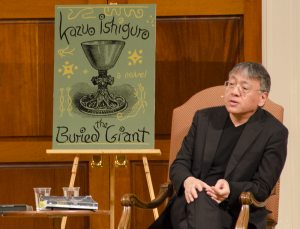
Fans of Kazuo Ishiguro’s “Never Let Me Go” have been waiting 10 years for the next novel by their favorite international best-selling writer. Unfortunately, most followers will likely be disappointed with his result, “The Buried Giant.”
Ishiguro is a remarkable storyteller, particularly because each of his books explores an entirely different genre than its predecessors. His two most famous novels intersect only because they take place in mid-20th-century England: “The Remains of the Day” is a quiet romance of a butler adjusting to post-war life, and “Never Let Me Go” is a science-fiction bildungsroman of teenage love cut short by technology. “The Buried Giant” makes an even greater departure from Ishiguro’s earlier works, rooting itself in the mythical world of King Arthur.
“The Buried Giant” is a peripatetic journey of forgiveness — an old couple unearthing the early memories of their marriage and two knights debating the diplomacy implications of violence and vengeance across tribal lines.
The protagonists, Beatrice and Axl, are an elderly, affectionate couple, who, like most elderly couples, have trouble recalling the past. But we quickly learn that their errors are in fact part of a collective amnesia which afflicts all the villages in the land.
Querig, the she-dragon, is the cause for this mist of forgetfulness. Intriguingly, the reader eventually learns that her magical breath has been part of a strategic move to keep peace among the fighting factions of the Britons and Saxons (the novel is set in the century after Britain defeated the Roman Empire).
Ishiguro explores the idea of forgetfulness on a micro and macro level. Axl and Beatrice set us off on the journey that becomes the novel’s central plot in their quest to reunite with their son, despite not being able to remember anything about him. And Sir Gawain (yes, of the Green Knight) and Wistan, a Briton and a Saxon, respectively, explore the usefulness of forgetfulness in its utility to preserve peace, however artificial.
On March 22, Ishiguro drew a packed house to Sixth & I Synagogue through an event coordinated by the local independent bookstore, Politics and Prose. There, he spoke about the current and recent conflicts in countries such as Yugoslavia, South Africa and Bosnia which inspired “The Buried Giant.” He was drawn to questions about the successes and failures of reconciliation in these countries. When is it better for a nation to remember things and when is it better to forget?
This theme would have been much more effective had Ishiguro chosen to ground these questions in a more realistic setting rather than in his fantasy world of ogres and dragons. These complex, powerful questions lose themselves in the setting of the novel.
One of the most frustrating aspects of the book was the many loose questions and plot threads left unanswered. Most fundamentally, Ishiguro never completely explains the rules of the world he has created (how does each village function as its own kingdom? Why do the Britons and Saxons hate each other?).
Furthermore, there are countless wisps of memories alluded to but never elaborated upon even once the mist finally does lift. Even the relevance of the title is never made clear. Most of these details are minor events in the book, but they accumulate and comprise the majority of the stories Axl and Beatrice encounter throughout their journey. The failure to tie these stories together and return to unanswered questions makes the reader feel as disoriented as Axl and Beatrice under the she-dragon’s breath.
“The Buried Giant” is a story that explores the role of memory over time, and it does take some time to get through. The novel is unlikely to appeal to the majority of college readers because there isn’t much we can relate to. Simply put, none of us have lived more than two decades, let alone been married for three or four. Another detriment: The plot often moves at the pace of this elderly couple.
Nevertheless, Ishiguro addresses some fascinating questions on the role of memory in our relationships, a theme he is famous for using in his other novels. In one of the more poignant moments of the book, Beatrice asks Axl how they know they love each other if they cannot recall any of their memories together:
“But then again I wonder if what we feel in our hearts today isn’t like the raindrops still falling on us from the soaked leaves above, even though the sky itself long stopped raining. I’m wondering if without our memories, there’s nothing for it but for our love to fade and die.”
In today’s world, it is impossible for urban young adults to escape their pasts. Because we record so much of our lives online, our photos, our emails and our relationships live on, in some form or another, forever.
But suppose for a moment that the dragon’s breath were somehow able to overtake our digital and human memories, forcing us only to live in the present with fleeting memories of the past. What, then, would we do? How would we define our affiliations to our communities and our loved ones?
This is the kind of ambiguity with which Ishiguro loves to play. Though not altogether successful in its delivery, “The Buried Giant” is an attempt to ask these provoking questions of people thrown into fantastic situations.














